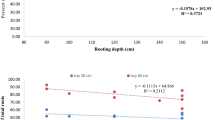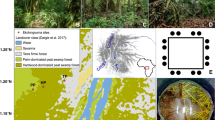Abstract
Plant root architecture reveals the sources of water and nutrients but tree root systems are large and difficult to analyze. With riparian (floodplain) trees, river cut-banks provide natural hydraulic excavation of root systems and this presents a unique study opportunity. Subsequently, we developed the ‘Cut-bank Root Method’, a simple, quantitative approach for analyzing the distribution of coarse roots, based on analyses of photographs of river cut-banks. These reveal the vertical extent of roots and median root depths (Rd). We applied this method along six rivers draining the Canadian Rocky Mountains and observed tenfold difference in Rd. The floodplain forests were dominated by cottonwoods and from mountain to prairie zones we observed progressively deeper roots of Populus trichocarpa (black cottonwood, Rd ~ 0.3 m), P. balsamifera (balsam poplar), P. angustifolia (narrowleaf cottonwood), and P. deltoides (prairie cottonwood, Rd ~ 0.9 m), which had Rd similar to P. fremontii (Fremont cottonwood) in Nevada, USA. Roots were shallower for co-occurring facultative riparian trees, with Rd ~ 0.1 m for P. tremuloides (trembling aspen) and Picea glauca (white spruce). Across the Canadian sites, Rd for cottonwoods were strongly associated with a growth season moisture index (May through September precipitation—potential evapotranspiration; R2 = 0.97, P < 0.001). Thus, in wetter climates, riparian cottonwoods were shallow-rooted and would be more dependent upon rain than stream flow. Conversely, in the drier semi-arid regions the cottonwoods were phreatophytic, with deeper root systems in the capillary fringe above the alluvial ground-water table. These phreatophytic cottonwoods would be highly dependent upon stream flow and vulnerable to declining river flows due to river regulation or climate change.








Similar content being viewed by others
References
Abernethy B, Rutherfurd ID (2001) The distribution and strength of riparian tree roots in relation to riverbank reinforcement. Hydrol Proc 15:63–79
Adair EC, Binkley D (2002) Co-limitations of first year Fremont cottonwood seedlings by nitrogen and water. Wetlands 22:425–429
Amlin NM, Rood SB (2001) Inundation tolerances of riparian willows and cottonwoods. J Am Water Resour Assoc 37:1709–1720
Braatne JH, Brunsfeld SJ, Hipkins VD, Wilson BL (2006) Naturalization of plains cottonwood (Populus deltoides subsp monilifera) along river drainages west of the Rocky Mountains. West N Am Nat 66:310–320
Braatne JH, Jamieson R, Gill KM, Rood SB (2007) Instream flows and the decline of riparian cottonwoods along the Yakima River, Washington, USA. River Res Appl 23:247–267
Busch DE, Ingraham NL, Smith SD (1992) Water uptake in woody riparian phreatophytes of the southwestern United States: a stable isotope study. Ecol Appl 2:450–459
Butnor JR, Doolittle JA, Kress L, Cohen S, Johnsen KH (2001) Use of ground-penetrating radar to study tree roots in the southeastern United States. Tree Physiol 21:1269–1278
Cordes LD, Hughes FMR, Getty M (1997) Factors affecting the regeneration and distribution of riparian woodlands along a northern prairie river: the Red Deer River, Alberta, Canada. J Biogeogr 24:675–695
Floate KD (2004) Extent and patterns of hybridization among the three species of Populus that constitute the riparian forest of southern Alberta, Canada. Can J Bot 82:253–264
Gale MR, Grigal DF (1987) Vertical root distributions of northern tree species in relation to successional status. Can J For Res 17:829–834
Gom LA, Rood SB (1999) The discrimination of cottonwood clones in a mature grove along the Oldman River in southern Alberta. Can J Bot 77:1084–1094
Hruska J, Cermak J, Sustek S (1999) Mapping tree root systems with ground-penetrating radar. Tree Physiol 19:125–130
Jackson RB, Canadell J, Ehleringer JR, Mooney HA, Sala OE, Schulze ED (1996) A global analysis of root distributions for terrestrial biomes. Oecologia 108:389–411
Kalischuk AR, Rood SB, Mahoney JM (2001) Environmental influences on seedling growth of cottonwood species following a major flood. For Ecol Manag 144:75–89
Lodge DJ (1989) The influence of soil moisture and flooding on formation of VA-endo- and ectomycorrhizae in Populus and Salix. Plant Soil 117:243–253
Lynch J (1995) Root architecture and plant productivity. Plant Physiol 109:7–13
Mahoney JM, Rood SB (1998) Streamflow requirements for cottonwood seedling recruitment—an integrative model. Wetlands 18:634–645
McBride JR, Strahan J (1984) Establishment and survival of woody riparian species on gravel bars of an intermittent stream. Am Midl Nat 112:235–245
McCabe GJ, Markstrom SL (2007) A monthly water-balance model driven by a graphical user interface. US Geological Survey, Reston, VA Open-file report 2007, 1088
Nadezhdinal N, Čermak J (2003) Instrumental methods for studies of structure and function of root systems of large trees. J Exp Bot 54:1511–1521
Nielsen JL, Rood SB, Pearce DW, Letts MG, Jiskoot H (2010) Streamside trees: responses of male, female and hybrid cottonwoods to flooding. Tree Physiol 30:1479–1488
Pearce DW, Millard S, Bray DF, Rood SB (2006) Stomatal characteristics of riparian poplar species in a semi-arid environment. Tree Physiol 26:211–218
Percival G (2008) Tree roots and buildings. In: Hitchmough J, Fieldhouse K (eds) Plant user handbook: a guide to effective specifying. Blackwell Sci Ltd, Oxford
Pezeshki SR (2001) Wetland plant responses to soil flooding. Env Exp Bot 46:299–312
Piotrowski JS, Lekbert Y, Harner MJ, Ramsey PW, Rillig MC (2008) Dynamics of mycorrhizae during development of riparian forests along an unregulated river. Ecography 31:245–253
Polzin ML, Rood SB (2006) Effective disturbance: seedling safe sites and patch recruitment of riparian cottonwoods after a major flood of a mountain river. Wetlands 26:965–980
Rood SB, Mahoney JM, Reid DE, Zilm L (1995) Instream flows and the decline of riparian cottonwoods along the St. Mary River, Alberta. Can J Bot 73:1250–1260
Rood SB, Taboulchanas K, Bradley CE, Kalischuk AR (1999) Influence of flow regulation on channel dynamics and riparian cottonwoods along the Bow River, Alberta. Rivers 7:33–48
Rood SB, Gourley C, Ammon EA, Heki LG, Klotz JR, Morrison ML, Mosley D, Scoppettone GG, Swanson S, Wagner PL (2003) Flows for floodplain forests: a successful riparian restoration. Bioscience 53:647–656
Rood SB, Pan J, Gill KM, Franks CG, Samuelson GM, Shepherd A (2008) Declining summer flows of Rocky Mountain rivers: historic hydrology and probable impacts on floodplain forests. J Hydrol 349:397–410
Rood SB, Nielsen JL, Shenton L, Gill KM, Letts MG (2010) Effects of flooding on leaf development, photosynthesis and water-use efficiency in narrowleaf cottonwood, a willow-like poplar. Photosynth Res 104:31–39
Schindler DW, Donahue WF (2006) An impending water crisis in Canada’s western prairie provinces. Proc Nat Acad Sci USA 103:7210–7216
Scott ML, Friedman JM, Auble GT (1996) Fluvial process and the establishment of bottomland trees. Geomorphology 14:327–339
Scott ML, Shafroth PB, Auble GT (1999) Responses of riparian cottonwoods to alluvial water table declines. Environ Manag 23:347–3580
Shafroth PB, Stromberg JC, Patten DT (2000) Woody riparian vegetation responses to different alluvial water table regimes. West N Am Nat 60:66–76
Smith SD, Devitt DA, Sala A, Cleverly JR, Busch DE (1998) Water relations of riparian plants from warm desert regions. Wetlands 18:687–696
Stromberg JC, Lite SJ, Dixon MD (2010) Effects of stream flow patterns on riparian vegetation of a semiarid river: implications for a changing climate. River Res Appl 26:712–729
Thornthwaite CW (1948) An approach toward a rational classification of climate. Geog Rev 38:55–94
Williams CA, Cooper DJ (2005) Mechanisms of riparian cottonwood decline along regulated rivers. Ecosystems 8:382–395
Woolfolk WT, Friend AL (2003) Growth response of cottonwood roots to varied NH4:NO3 ratios in enriched patches. Tree Physiol 23:427–432
Acknowledgments
Funding was provided by the Natural Sciences and Engineering Research Council of Canada and the Alberta Water Research Institute and we acknowledge the assistance of Karen Gill and David Pearce (University of Lethbridge).
Author information
Authors and Affiliations
Corresponding author
Additional information
Communicated by R. D. Guy.
Rights and permissions
About this article
Cite this article
Rood, S.B., Bigelow, S.G. & Hall, A.A. Root architecture of riparian trees: river cut-banks provide natural hydraulic excavation, revealing that cottonwoods are facultative phreatophytes. Trees 25, 907–917 (2011). https://doi.org/10.1007/s00468-011-0565-7
Received:
Revised:
Accepted:
Published:
Issue Date:
DOI: https://doi.org/10.1007/s00468-011-0565-7




